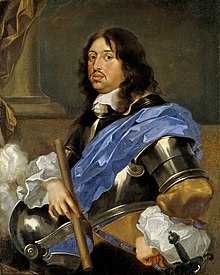Charles X of Sweden
| Charles X Gustaf | |
|---|---|

Karl X Gustav by Sébastien Bourdon
|
|
|
King of Sweden Duke of Bremen and Verden |
|
| Reign | 6 June 1654 – 13 February 1660 |
| Predecessor | Christina |
| Successor | Charles XI |
| Born |
8 November 1622 Nyköping Castle, Sweden |
| Died | 13 February 1660 (aged 37) Gothenburg, Sweden |
| Burial | 4 November 1660 Riddarholmen Church, |
| Spouse | Hedwig Eleonora of Holstein-Gottorp |
| Issue | Charles XI |
| House | Palatinate-Zweibrücken |
| Father | John Casimir, Count Palatine of Zweibrücken-Kleeburg |
| Mother | Catherine of Sweden |
| Religion | Lutheran |
| Signature | |
Charles X Gustav, also Carl Gustav (Swedish: Karl X Gustav; 8 November 1622 – 13 February 1660), was King of Sweden from 1654 until his death. He was the son of John Casimir, Count Palatine of Zweibrücken-Kleeburg and Catherine of Sweden. After his father's death he also succeeded him as Pfalzgraf. He was married to Hedwig Eleonora of Holstein-Gottorp, who bore his son and successor, Charles XI. Charles X Gustav was the second Wittelsbach king of Sweden after the childless king Christopher of Bavaria (1441–1448) and he was the first king of the Swedish Caroline era, which had its peak during the end of the reign of his son, Charles XI. He led Sweden during the Second Northern War, enlarging the Swedish Empire. By his predecessor Christina, he was considered de facto Duke of Eyland (Öland) before ascending to the Swedish throne.
His numbering as Charles X derives from a 16th-century invention. The Swedish king Charles IX (1604–1611) chose his numeral after studying a fictitious history of Sweden. This king was the fourth actual King Charles, but has never been called Charles IV.
In his early childhood raised in the Swedish court alongside Queen Christina he received an excellent civil education. Later Charles X learned the art of war under Lennart Torstenson, being present at the second Battle of Breitenfeld (1642) and at Jankowitz (1645). From 1646 to 1648 he frequented the Swedish court, supposedly as a prospective husband of his cousin the queen regnant, Christina of Sweden (1626–89, reigned 1632–54), but her insurmountable objection to wedlock put an end to these anticipations, and to compensate her cousin for a broken half-promise she declared him her successor in 1649, despite the opposition of the Privy Council headed by Axel Oxenstierna. In 1648 he gained the appointment of commander of the Swedish forces in Germany. The conclusion of the treaties of Westphalia in October 1648 prevented him from winning the military laurels he is said to have desired, but as the Swedish plenipotentiary at the executive congress of Nuremberg, he had an opportunity to learn diplomacy, a science he is described as having quickly mastered. As the recognized heir to the throne, his position on his return to Sweden was dangerous because of the growing discontent with the queen. He therefore withdrew to the isle of Öland until the abdication of Christina on 5 June 1654 called him to the throne.
...
Wikipedia
